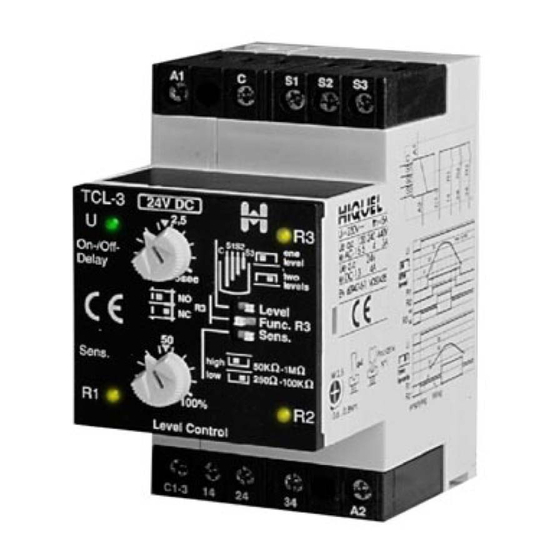
Table of Contents
Advertisement
Quick Links
HIQUEL GmbH
TCL/PCL application instruction
Function
For supervising and/or controlling fill factors electronic level indicators/controls are required.
Our products with the following type designations represent such devices: TCL, PCL and
TCL3. Because of simplicity reasons, all these devices in this document are designated as
level controls. In the case of differences between the devices we will deal in a separated
manner with it.
Operating range
The application of the level control requires the fulfilment of the following:
•
The liquid you want to measure must be conductive.
•
The liquid you want to measure must not be flammable.
•
The liquid you want to measure must have its conductivity within the available
measuring range.
•
Make sure that the sensor cabling is placed within a shielded cable away from AC
cabling or engine cabling.
Conductive liquids
Resistor calculation
The calculation of the resistance of the medium is possible. For this, the size of the
electrodes must be known.
1
=
R
c
*
p
A =
d =
c =
p =
An equivalent means the amount of molecules of the liquid. There is one positive molecule
and one negative. For example, one molecule NaCl means Na
case is 1. One molecule CaCl
Usually the size of the electrodes is not measured, but the d/A ratio is acquired when
measuring the resistance of a cell with a defined concentration and a known equivalent
conductivity. In some cases the cell constant will be necessary for measuring with the level
control.
Author:
Peter Reiter
Translator: Markus Rindler
d
*
A
Size of the electrodes [cm³]
Gap of the electrodes [cm]
Concentration [val/cm³]
equivalent conductivity [Scm²/val]
means Ca
2
File:
Date:
++
-
+ 2CL
the equivalent is ½.
HIQUEL_AppNote_TCL_1_E_R0100.doc
05.07.2004 12:56
Page 1
+
-
+ CL
the equivalent in this
Advertisement
Table of Contents

Summary of Contents for HIQUEL TCL
- Page 1 Function For supervising and/or controlling fill factors electronic level indicators/controls are required. Our products with the following type designations represent such devices: TCL, PCL and TCL3. Because of simplicity reasons, all these devices in this document are designated as level controls. In the case of differences between the devices we will deal in a separated manner with it.
- Page 2 Measuring conductive liquids is not as easy as measuring the resistance of ohmic resistors. The liquids are not completely ohmic and you have to avoid a material wander. The TCL considers these problems and uses a very small ac for resistance measuring. Function description...
- Page 3 HIQUEL GmbH Page 3 Deplete Function: As long as the fill factor reaches S1, the relay (R) will be active. TCL-230Vac Level control with two fill factors Fill Function: The relay (R) becomes active as soon as both sensors (S1, S2) are not covered. It switches off as soon as both sensors get in contact with the medium.
- Page 4 From experience this case can be excluded, therefore we do not recommend the use of devices without galvanic separated supply. Earthing Because of safety reasons you have to ground connection „C“ of the TCL near the liquid receptacle. The respective rules have to be considered. Wire Use a shielded cable for the cabling.
- Page 5 HIQUEL GmbH Page 5 Measuring range The TCL has 2 switchable measuring ranges (sensitivity). First measuring range is between 250 1.000.000 Ohm and 100kOhm (LOW), second is between 50kOhm and 1MOhm (HIGH). Through switch- HIGH 100.000 hysteresis, due to component tolerances and 50.000...
- Page 6 HIQUEL GmbH Page 6 Level control with one fill factor Deplete Connect the level control completely and bring the sensor in position. Fill the receptacle in such a way that the sensor is a little immersed (maximum fill factor). Adjust front switch to: one level, filling, high sensitivity. Rotate potentiometer clockwise to the stop.
- Page 7 Great care has been taken in the creation of the text, illustrations and program examples in this manual. Neither HIQUEL, their authors nor their interpreters may be held responsible for any errors herein, nor can they be held responsible or liable for consequences arising from any errors herein.
Need help?
Do you have a question about the TCL and is the answer not in the manual?
Questions and answers